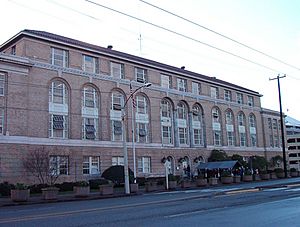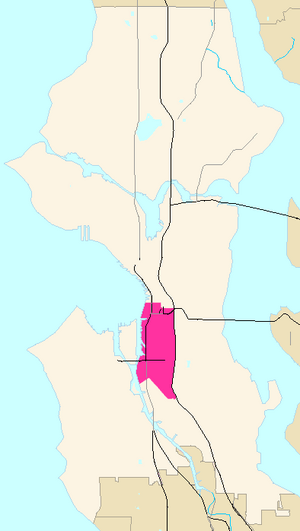Industrial District, Seattle facts for kids
Quick facts for kids
Industrial District, Seattle
|
|
|---|---|
|
Seattle Neighborhood
|
|

The old immigration building at the northern end of the neighborhood on Airport Way S.
|
|

Industrial District Highlighted in Pink
|
|
| Country | United States |
| State | Washington |
| County | King |
| City | Seattle |
| Zip Code |
98134
|
| Area Code | 206 |
The Industrial District is a very busy area in Seattle, Washington. It's where many factories, warehouses, and businesses are located. This district is important for shipping and making goods.
A well-known part of this area is called SoDo. The name "SoDo" is a fun way to say "South of Downtown." SoDo is famous because it's home to Seattle's major sports stadiums.
Contents
About the Industrial District
The Industrial District is bordered by the Duwamish River and Elliott Bay to the west. To the east, you'll find Interstate 5. On its northern side are Pioneer Square and the International District. To the south, it's next to Georgetown.
What is SoDo?
SoDo is the northwestern part of the Industrial District. It's a popular spot, especially for sports fans! It's where you'll find:
- T-Mobile Park, which is the home stadium for the Seattle Mariners baseball team.
- Lumen Field, where the Seattle Seahawks football team and Seattle Sounders FC soccer team play. Lumen Field was also built where the old Kingdome stadium used to be.
How the Land Was Formed
A lot of the Industrial District is built on land that was once mudflats and low areas. These were part of Elliott Bay and the Duwamish estuary (where the river meets the sea). Between 1902 and 1907, people worked to dig up, straighten, and fill in these areas to create more usable land.
Because much of the area is built on this "landfill," it can be prone to something called liquefaction. This means that during an earthquake, the ground can sometimes act like a liquid, which can make buildings more likely to be damaged.
Main Roads and Routes
Getting around the Industrial District is easy with several main roads. Some of the important ones include First and Fourth Avenues S, Alaskan Way, and East Marginal and Airport Ways S. For east and west travel, you have S Spokane, the Spokane Street Viaduct, the West Seattle Bridge, and S Royal Brougham Way.
A Look Back in Time
The area that is now Seattle has been lived in for a very long time, even since the end of the last Ice Age, about 8,000 years ago.
Early Inhabitants
Long before modern Seattle was built, Native American tribes lived here. For example, villages like tohl-AHL-too and hah-AH-poos were located in what is now the Industrial District. These villages were at the mouth of the Duwamish River and had been inhabited since the 6th century CE.
The Dkhw’Duw’Absh and Xacuabš people, who are part of the Duwamish tribe of the Coast Salish nations, lived in many villages in the mid-1850s. They had permanent longhouses along the local bays and rivers, including the Duwamish.
Modern Development
In 1905, the Seattle Box Company moved to the Industrial District. This made them one of the first businesses to set up shop in this growing industrial area.
A very famous company, Starbucks, moved its world headquarters to the Industrial District in 1997. Their headquarters is in a large building that was originally built in 1912 for Sears, Roebuck and Company. It was used as a center to distribute their catalogs.
What's Here Today?
The Industrial District is still a very active place for businesses.
Major Businesses
Besides Starbucks, another well-known company with its headquarters in the Industrial District is Uwajimaya. It's a large Asian supermarket chain.
Some business owners in the Industrial District are thinking about what the future holds for the area. Some city planners see this district as a good place to expand other types of businesses and even build more homes, moving south from Downtown Seattle.

